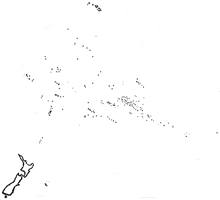
|
The Society of Folk Dance Historians (SFDH) Polynesia
[
Home |
About |
Encyclopedia | CLICK IMAGE TO ENLARGE |

|
BACKGROUND
Information: A subregion.
Polynesia is a subregion of Oceania, made up of more than 1,000 islands scattered over the central and southern Pacific Ocean. The indigenous people who inhabit the islands of Polynesia are termed Polynesians, and share many similar traits including language family, culture, and beliefs. Historically, they had a strong tradition of sailing and using stars to navigate at night. The largest country in Polynesia is New Zealand.
Polynesia is characterized by a small amount of land spread over a very large portion of the mid and southern Pacific Ocean. Most Polynesian islands and archipelagos, including the Hawaiʻian Islands and Samoa, are composed of volcanic islands built by hotspots (volcanoes). New Zealand, Norfolk Island, and Ouvéa, the Polynesian outlier near New Caledonia, are the unsubmerged portions of the largely sunken continent of Zealandia. Zealandia is believed to have mostly sunk 23 million years ago and recently resurfaced geologically due to a change in the movements of the Pacific Plate in relation to the Indo-Australian plate, which served to uplift the New Zealand portion.
Polynesia is generally defined as the islands within the Polynesian Triangle, although some islands inhabited by Polynesian people are situated outside the Polynesian Triangle. Geographically, the Polynesian Triangle is drawn by connecting the points of Hawaiʻi, New Zealand, and Easter Island. The other main island groups located within the Polynesian Triangle are Samoa, Tonga, the Cook Islands, Tuvalu, Tokelau, Niue, Wallis and Futuna, and French Polynesia. Also, small Polynesian settlements are in Papua New Guinea, the Solomon Islands, the Caroline Islands, and Vanuatu. An island group with strong Polynesian cultural traits outside of this great triangle is Rotuma, situated north of Fiji. The people of Rotuma have many common Polynesian traits, but speak a non-Polynesian language. Some of the Lau Islands to the southeast of Fiji have strong historic and cultural links with Tonga.
Historically, the islands of the South Seas have been known as South Sea Islands, and their inhabitants as South Sea Islanders, even though the Hawaiʻian Islands are located in the North Pacific and Fiji is not considered part of Polynesia.
Languages: Polynesian languages are all members of the family of Oceanic languages, a sub-branch of the Austronesian language family.
Religions: The religious attributes of Polynesians were common over the whole Pacific region. Beginning in the 1820s large numbers of missionaries worked in the islands, converting many groups to Christianity.
ISLANDS OF POLYNESIA
- Australia
- Austral
- Baker
- Chatham
- Christmas
- Cook
- Easter
- Fanning
- French Polynesia
- Gambier
- Hawaiʻi
- Hiue
- Howland
- Jarvis
- Johnston
- Kermadec
- Kingman
- Line
- Marquesas
- New Zealand
- Palmyra
- Phoenix
- Pitcairn
- Rapa Nui
- Samoa
- Society
- Tahiti
- Tokelau
- Tonga
- Tuamotu
- Tuvalu
- Wallis
DOCUMENTS
- National Geographic Magazine Folklore Index 1914-1997, a list.
- Polynesian History, an article.
This page © 2018 by Ron Houston.
Please do not copy any part of this page without including this copyright notice.
Please do not copy small portions out of context.
Please do not copy large portions without permission from Ron Houston.